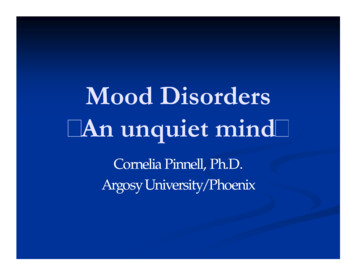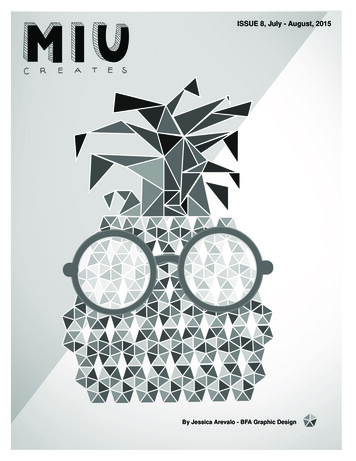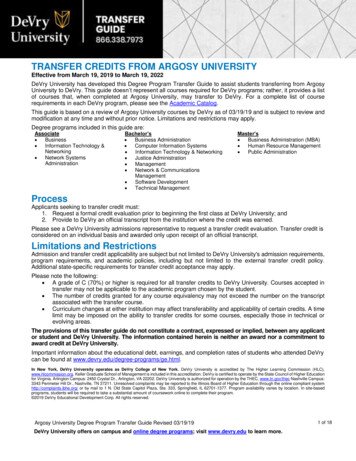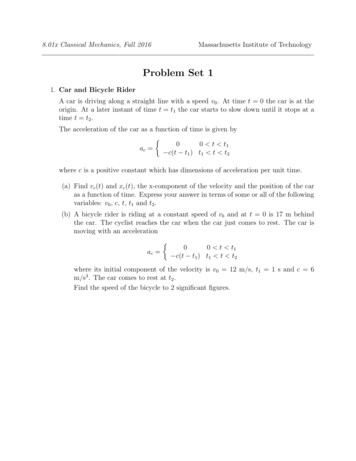
Transcription
Mood DisordersAn unquiet mindCornelia Pinnell, Ph.D.Argosy University/Phoenix
Lecture OutlinennnnDefinitionsHistory of relevant conceptsPhenomenology of depression/maniaStructure of mood disordersUnipolarn Bipolar – I & IInnnCultural issuesEtiological models of depression
Mood ConceptsnAFFECT Broad term encompassing moods,emotions, motivations and feelings, the whole sphere ofpsychic lifenMOOD Relatively persistent, dominating affectnEMOTION Fleeting experiencePaul McHugh & Phillip Slavney, 1998
Mood Conceptsn AFFECT A pattern of observable behaviorsthat is the expression of a subjectively experiencedweather’’.feeling state - refers to emotional ‘weatherExamples:: sadness, elation, anger, etc.Examplesn MOOD Pervasive and sustained emotional ‘climateclimate’’DSM--IVDSMIV--TR
Disturbances in affectnnnBlunted significant reduction in intensity ofemotional expressionFlat Absence or near absence of any signs ofaffective expressionRestricted/ constricted Mild reduction in the rangeand intensity of emotional expression
Disturbances in affectnnLabile Abnormal variability in affect withrepeated, rapid and abrupt shifts in affectiveexpressionInappropriate Discordance between affectiveexpression and the content of speech or ideation
History of ConceptsnPinel & other early clinicians (late 18th century)distinguished between two clinical aspects ofsevere insanity:n Affectional insanity (characterized bydisturbed emotions)n Ideational insanity (characterized bydisturbed thoughts and beliefs, without aprominent change in mood)
History of ConceptsnEmil Kraepelin first described manicmanic-depressivedisorder and schizophrenianManic--depressive insanity circular insanities,Manicsimple manias, & involutional melancholia; it neverled to a profound deterioration of personality orthinkingn Dementia preacox (term first used by the Frenchpsychiatrist BenoîBenoît Morel) a disturbance inthinking, emotion, and volition which eventually ledto the destruction of the personality
History of ConceptsnnnEugen Bleuler coined the word ‘schizophreniaschizophrenia’’ anddescribed a group of schizophrenias wherethought disorder was centralAdolf Meyer characterized manicmanic-depressivedisorder and schizophrenia as reactionsKarl Jaspers - similar psychological events mightbe produced by circumstance in some case, bydisease processes in others
Phenomenology of depressionThe depressed patient may feel diseased, poor,blameworthy, or useless; becomes withdrawn and losesinterest in most activities, including those that usuallygive him pleasure and comfort. Even the perceptionsof the environment may become dulled, sounds aremuffled, colors faded or darkened, food tasteless.There may be a generalized slowing down,psychomotor retardation, answering slowly if at all, canappear ill, thinking is slowand inefficient, fatigue andphysical discomfort; walking with a gait, posture,rigidity and facial expression suggestive ofParkinsonism.
Phenomenology of depressionA stuporous condition is the mostsevere manifestation, with the patientbedridden, incontinent, mute, unableto feed or care for himself, and indanger of death if not properlydiagnosed and treated.
Criteria forMajor Depressive EpisodennnCriterion A: Five (or more) of the following sxspresent for 2 weeks,weeks, a change from previousfunctioning: depressed mood, anhedonia, sig.weight loss/gain, insomnia/hypersomnia,psychomotor agitation/retardation,fatigue/anergia, poor concentration,worthlessness, suicidal ideationCriterion B: Sxs do not meet criteria for a MixedepisodeCriterion C: Sxs cause significant distress orimpairment
Phenomenology of maniaThe manic patient may believe he is healthy,rich, famous, talented, powerful. Social andother activities increase and perceptions becomebrighter and more intense. Thoughts might beexperienced effortless and rapid, body filled withenergy & healthy. The patient becomesincreasingly active until the behavior takes on anuncontrollable driven quality, thoughts becomechaotic & responsive to every distraction so thatsustained, goalgoal-directed thinking is impossible.
Criteria for Manic EpisodenCriterion A: A distinct period of abnormally persistentlyelevated, expansive, or irritable mood, lasting at least 1 week (orany duration if hospitalization is necessary)nCriterion B: During the period of mood disturbance, 3 (ormore) of the following sxs are present: inflated selfself-esteem orgrandiosity, decreased need for sleep, pressured speech, flight ofideas/racing thoughts, distractibility, increased goalgoal-directedactivity/psychomotor agitation, excessive involvement inpleasurable activities with high potential for painfulconsequences
Structure of Mood DisordersnnUnipolar (depression)BipolarBipolar I (with mania)n Bipolar II (with hypomania)n
Depressive Disordersnnnn296.2x Major depressive disorder,disorder, single episode(50%)296.3x Major depressive disorder,disorder, recurrent (2ms btw. episodes)300.4 Dysthymic disorder (persistent depressedmood 2 y ); specifiersspecifiers:: early (before age 21) orlate onset; atypicalDouble depression (dysthymia major depressiveepisode)
Specifiers for MDDnIf full criteria for MDD are metMild, Moderate, Severe with/without psychoticfeaturesn Chronicn With Catatonic featuresn With Melancholic featuresn With Atypical featuresn With Postpartum onsetn
Specifiers for MDDnIf full criteria for MDD are not metIn Partial Remission/Full Remissionn Chronicn With Catatonic featuresn With Melancholic featuresn With Atypical featuresn With Postpartum onsetn
311 Depressive Disorder NOSnnnnPremenstrual Dysphoric DisorderMinor Depressive DisorderRecurrent Brief Depressive Disorder(2 days , but less than 2 weeks)Postpsychotic Depressive Disorder(Major Depressive Episode during theresidual phase of Schizophrenia)
Further studynnnnAlternative Criterion B for Dysthymic DisorderMinor Depressive Disorder(less impairment & fewer symptoms)Recurrent Brief Depressive Disorder(2 days , but less than 2 weeks)Mixed AnxietyAnxiety-Depressive Disorder
Alternative Criterion B forDysthymic DisorderPresence, while depressed, of 3 (ormore) of the following:nnnnLowself-esteem or selfLowselfself-confidence, orfeelings of inadequacyFeelings of pessimism, despair, orhopelessnessGeneralized loss of interest or pleasureSocial withdrawal
Alternative Criterion B forDysthymic DisordernnnnnChronic fatigue or tirednessFeelings of guilt, brooding about the pastSubjective feelings of irritability or excessiveangerDecreased activity, effectiveness, orproductivityDifficulty in thinking – poor concentration/memory, indecisiveness
Mixed AnxietyAnxiety-Depressive DisordernnCriterion A: Persistent or recurrent dysphoricmood lasting at least 1 monthThe dysphoric mood is accompanied by atleast 1 month of four (or more) of thefollowing symptoms:1.2.3.Difficulty concentrating or mind going blankSleep disturbance (difficulty falling or stayingasleep, or restless, unsatisfying sleep)Fatigue or lowenergy
Mixed AnxietyAnxiety-Depressive yBeing easily moved to tearsHypervigilanceAnticipating the worstHopelessness (pervasive pessimism about the future)Lowself--esteem or feelings of worthlessnessLowself
Bipolar I Disordernnnnnn296.0x Bipolar I, Single Manic Episode296.40 Bipolar I, Most Recent HypomanicEpisode296.4x Bipolar I, Most Recent Manic Episode296.6x Bipolar I, Most Recent Episode Mixed296.5 Bipolar I, Most Recent EpisodeDepressed296.7 Bipolar I, Most Recent EpisodeUnspecified
Specifiers for Bipolar I DisordernIf criteria are met for a manic or mixed episode:Mild, Moderate, Severe with/without psychoticfeatures, In Partial Remission, In Full Remissionn With Catatonic Featuresn With Postpartum Onsetn
Specifiers for Bipolar I DisordernOnly to the current (or most recent) MajorDepressive EpisodeChronicn With Melancholic Featuresn With Atypical Featuresn
Specifiers for Bipolar I DisordernnnLongitudinal Course Specifiers (With/WithoutInterepisode Recovery)With Seasonal Pattern (applies only to thepattern of Major Depressive Episodes)With Rapid Cycling
Bipolar II Disordern296.89 Bipolar II Disorder (Recurrent MajorDepressive Episodes with Hypomanic Episodes)nSpecify current or most recent episode:n Hypomanicn Depressed
Bipolar II DisordernSpecifiers to describe the current/most recent MajorDepressive Episode in Bipolar II Disordern Mild, Moderate, Severe with/without psychoticfeatures, In Partial Remission, In Full Remissionn Chronicn With Catatonic Featuresn With Melancholic Featuresn With Atypical Featuresn With Postpartum Onset
301.13 Cyclothymic DisordernCriterion A: For at least 2 years,years, presence of numeroushypomanic sxs and depressive sxs that do not meetcriteria for a Major Depressive EpisodennCriterion B: During the 2-year period,period, the person hasnot been without sxs for more than 2 months at a timeNo Major Depressive, Manic or Mixed Episode duringthe first 2 years of the disturbance – After 2 years, bothCyclothymia and Bipolar I or II may be dx
EpidemiologynnPrevalence rates for MDD:n Female to Male ratio 2 : 1n Lifetime risk for females: 1010-25%Incidence rates for MDD (increasing):n 1% by age 75 (of Am. born before 1905)n 6% by age 24 (of Am. born after 1955)
Lifetime Prevalence
Lifetime Prevalence
Course of Depressive DisordersnnnnAge of onset:n Major DD – mid 20sn Early onset Dysthymia – before age 21Onset often related to a psychosocial stressorVariable length of episodes (from 2 weeks toyears, average 9 months; for Dysthymia, from2020-30 years, median duration 5 years)5050-60% will have more than one depressiveepisode; 55-10% will develop Bipolar I Disorder
Course of Depressive Disorders
ComorbiditynnnHigh comorbidity of mood disorders withanxiety disorders and alcohol abuse/dependenceMen (both unipolar and bipolar disorders) morefrequently present with substance abuse; womenmore frequently present with anxiety & eatingdisordersSubstance use disorders, panic d. and OCD are2x more frequently (each) present in patientswith bipolar d. vs. unipolar d.
Cultural issues in mood disordersnCultural differences in the experience andexpression of sadness and other depressedemotions – different idiomsn Westerners tend to psychologizen Nonwesterners tend to somaticize
Depression in MicronesiannnLalomweiu, the closest to the western idea ofLalomweiu,major depression, is conceptualized as lonelinessor sadness caused by the loss of a loved oneFago means feeling sorrowand compassion forothers’ loss of loved onesPak is homesickness experienced by travelerswho are missing their loved ones at home
Depressionamong Native AmericansFor Native Americans of the FlatheadReservation, depression can have positiveconnotations, as it may be interpreted assignifying maturity and recognition of thetremendous loss experienced by NativeAmericans through domination by AngloAmerican societyCastillo, 1997
Etiological models of depressionnBiological modelsn Genetic vulnerability (polygenic)n Neurotransmitters - shift toward studyingneurobehavioral systems, neural circuits &neuroregulatory mechanismsn Pathologyof the brain/ neuroanatomyn Endocrine hypothesisn Circadian rhythms
Genetic vulnerabilitynThe search for one gene, markers on the Xchomozome or on chromozome 11 for bipolar Idisorder have not been supportednThere is some evidence for polygenic transmission
Genetic vulnerabilitynnnTwin studies: 3x higher incidence in MZ thanDZ (concordance increases with severity)Adoption studies: inconsistent findingsUseful terms:n Proband (individual with the disorder)n Relatives (higher morbid risk for a mood disorder inrelatives of a proband)
Genetic vulnerabilitynThere is some evidence of joint heritabilityforanxiety& depression.nIt is not possible to separate genetic fromenvironmental factors. Depressed mothers areineffectual disciplinarians, unable to cope withstress, model depressive behaviors (Sherman,1987).
Neurotransmitter hypothesesnCathecolamine hypothesisn Lowepinephrine – depressionn High epinephrine - manianIndolamine hypothesisn Lowserotonin levels - depression
Neurotransmitter hypothesesnPermissive hypothesis:hypothesis: lowlevels of serotonininteract with other neurotransmitter systems(norepinephrine & dopamine)
Pathological neuroanatomy
Endocrine hypothesisnHigh cortisol levels in depression.n50%of depressed Ps showreduced suppressionin the dexamethazone suppression test
Circadian rhythms hypothesisnDepressed people:people: REM sleep starts earlier;stages of deep sleep occur later, if at all; sleepdeprivation (2nd stage of night sleep) leads toimprovement.n Extended insomnia may trigger a manic episodenBipolar disorder Ps: increased sensitivity to light(greater suppression of melatonin when exposedto light at night)
Psychologicalmodels of depressionAll psychological models have in common the themeof lossn Psychoanalytic formulationsn Psychosocial modelsn Behavioral modelsn Cognitive models
Psychoanalytic formulationsnAbraham-Freud (1911, 1917) - ‘blockage of libido’Abrahamlibido’through object loss; ambivalent feelings (love(lovehate) toward the object – unacceptable hostilityisturned inward (retroflected)n No empirical support
Psychoanalytic formulationsnSpitz (1945) described ‘anaclitic depression’depression’ ininfants separated from their mothers in the 2ndhalf of their lives - characterized byapprehension, crying, withdrawal, psychomotorslowing, dejection, stupor, insomnia, anorexia,weight loss, gross retardation in growth anddevelopment
Psychoanalytic formulationsBribring (1965): Depression results from the ego beingBribring(1965):cognizant of its goals and its helplessness to attain them inability to live up to one’one’s ego ideals (e.g., wish to beworthy and to be loved, the strivings to be secure,strong and superior, the aspiration to be good, kind,loving, and humane); the ego suffers a narcissistic injuryand collapse in selfself-esteemn Hostility is secondary to object loss and/or targetingobjects that prevent the attainment of desired/cherished aspirations
Psychoanalytic formulationsnBowlby (1973): Depression results from objectBowlby(1973):loss, traumatic separation from significantobjects of attachment, especially from anambivalently loved one. No empirical support.nKohut: A damaged self, with a fragile sense ofKohut:self--esteem may result in “empty depression”selfdepression”(dominated by feelings of boredom) or in “guiltydepression””.depression
Psychoanalytic formulationsnPsychodynamic factors in manian Manic episodes defense against underlyingdepression; may result as a reaction to atyrannical and overcritical superego, replacingintolerable self-criticism with euphoric selfsatisfactionKarl Abraham
Behavioral modelsnFerster (1966, 1973): loss of reinforcible behaviornLewinsohn (1970): social skill deficits:deficits: lowamount ofverbal production, low# of times behavior isinitiated; delayed latency of response to others;lowrate of positive/reinforcing behaviors
Behavioral modelsnCostello (1972): reinforcers are available and theindividual may still be capable of procuringthem, but they have lost their potencyas reinforcersnCoyne (1976): depressed individuals have analienatingeffect on others (during phoneinteractions) – lowfrequency & quality of socialreinforcers
Behavioral modelsnRehm (1977) developed Kanfer’Rehm(1977)Kanfer’s (1970) selfself-control& selfself-regulation model which divided the controlthat individuals have over their behaviors into 3stages: 1) selfself-monitoring, 2) selfself--evaluation, 3)self--reinforcement.selfDepressed individuals are hypothesized toattend selectivelyto negative aspects of themselves.themselves.
Behavioral modelsnLewinsohn (1988) - correlates of depression:n Demographics (young, female, lowSES, loweducation, divorced/separated, unemployed);high levels of stressstress;;n Social relationships (isolated; uncomfortablein social interactions; reduced pleasure);n Personal factors:factors: lowselflowself-esteem, negativecognitive triad, less control in life, irrationalbeliefs
Psychosocial modelsEmphasis on social & cultural factors:factors:n Marital status:status: marital disruption often precedesdepressionn Gender roles:roles: mastery & controllability of eventsstrongly encouraged in males, but not infemales; females value intimacy; rumination overemotionsn Social support:support: support & conflict as separatedimensions
Psychosocial modelsLife events & coping:coping:n Brown & Harris (1978): depression often occursfollowing a severe/acute stressful event or aftermajor chronic difficulties lasting more than 2 yn Billing (1983): vulnerability to depressionincreases with the number of “life strains”strains”n Lazarus & Folkman (1986) depressed peoplehave highly ineffective coping styles
Cognitive modelsnMartin Seligman (1974, 1975): learned helplessness &perception of noncontrol; specificity ofhelplessness to depression:depression: a number of studieshave shown that helplessness induction resultsin increased anxiety, hostility and depression
Cognitive modelsnMartin Seligman (1981): attributional reformulation maladaptive attributional style of depressedindividuals is characterized by internal, global,stable attributions; integrates the concepts ofcognitive vulnerability&vulnerability & stressful life events & inabilityto cope
Cognitive modelsnAaron Beck (1967, 1974): Depressed affect is secondaryto a set of negative cognitions.Depressive cognitions are at the root of depression negative cognitive triad (self, world, future) and faultyreasoning; the development of depressive schemasoccurs over a period of years.n Cognitive negative triad plays an important role both inthe etiology and the maintenance of depression.
Integrative multifactorial modelnHagop Akiskal (1976): “Depressive illness, as afinal common pathway, is the culmination ofvarious processes that conceivably converge inthose area of the diencephalon that modulatearousal, mood, motivation and psychomotorfunctioning.”
Integrative multifactorial modelnHagop Akiskal (1976): The specific form that thesyndrome will take in a given individual willdepend on the interaction of:n Genetic vulnerabilityn Developmental events - sensitization todepressionn Psychosocial acute or chronic stressorsn Physiological stressorsn Personality traits
ReferencesnnnAmerican Psychiatric Association (2000).Diagnostic and statistical manual of mental disorders,(4th ed., Text Revision). Washington, DC: Author.Castillo, R. J. (1997). Culture and mental illness. Aclient-centered approach. NewYork: Brooks/Cole.Jamison, K. R. (1997). An unquiet mind. A memoirof moods and madness. NewYork: Alfred A.Knopf.
ReferencesnnMcHugh, P. R , & Slavney, P.R. (1998). ThePerspectives of Psychiatry(2nd ed.). Baltimore, MD:The Johns Hopkins University Press.Sadock, B. J., & Sadock, V. A. (2007). Kaplan &Sadock’s synopsis of psychiatry(10th ed.). Baltimore,Maryland: Williams and Wilkins.
Argosy University/Phoenix. Lecture Outline nn Definitions nn History of relevant concepts nn Phenomenology of depression/mania nn Structure of mood disorders . muffled, colors faded or darkened, food tasteless. There may be a generalized slowing down,











